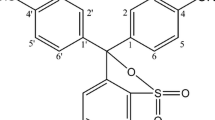Summary
A method for the determination of organic isothiocyanates is described. The isothiocyanates on reacting with excess ofn-butylamine in dimethylformamide form N,N′-disubstituted thioureas which are determined by oxidation with iodine trichloride. Each mole of thiourea consumes 8 oxidizing equivalents. Two procedures for determining mixtures of isothiocyanate and isocyanate or thiourea are also presented. In the first procedure, a total of isothiocyanate and isocyanate is determined by reacting the mixture with excessn-butylamine and back titrating the residual amine acidimetrically. The isothiocyanate content is determined on a second aliquot by iodine trichloride oxidation of the thioureas formed from isothiocyanate by its reaction with amine. In the second procedure, the isothiocyanate is determined by reaction with excess amine and following an acidimetric titration. Then, the thiourea originally present plus that formed from isothiocyanate, upon reaction with the second aliquot withn-butylamine, are determined by iodine trichloride oxidation. Acidic or basic substances, carbonyl compounds and anhydrides do not interfer.
Zusammenfassung
Isothiocyanate bilden bei Reaktion mit einem Überschuß vonn-Butylamin in Dimethylformamid N,N′-disubstituierte Thioharnstoffe, die sich durch Oxydation mit Jodtrichlorid bestimmen lassen. Pro Mol Thioharnstoff werden 8 Oxydationsäquivalente verbraucht. Außerdem wurden zwei Verfahren zur Bestimmung von Gemischen aus Isothiocyanat und Isocyanat oder Thioharnstoff angegeben. Bei dem einen Verfahren wird die Summe von Isothiocyanat und Isocyanat durch Umsetzung mit einem Überschuß vonn-Butylamin und Rücktitration mit Säure bestimmt. Das Isothiocyanat wird in einem zweiten Probeanteil durch Oxydation des aus Isothiocyanat mit Amin gebildeten Thioharnstoffs bestimmt. Bei dem zweiten Verfahren wird das Isothiocyanat durch Umsetzung mit überschüssigem Amin und nachfolgender acidimetrischer Titration bestimmt. Dann wird der ursprünglich vorhandene Thioharnstoff und der aus Isothiocyanat bei der Umsetzung mit einem zweiten Aliquotn-Butylamin entstandene Thioharnstoff durch Oxydation mit Jodtrichlorid bestimmt. Saure oder basische Substanzen, Carbonylverbindungen und Anhydride stören nicht.
Similar content being viewed by others
Literatur
N. D. Cheronis and T. S. Ma, Organic Functional Group Analysis, New York: Wiley. 1964. p. 297.
S. Siggia and J. G. Hanna, Analyt. Chemistry20, 1084 (1948).
B. S. Karten and T. S. Ma, Microchem. J.3, 507 (1959).
J. A. Vinson, Analyt. Chemistry41, 1661 (1969).
P. C. Gupta, Z. analyt. Chem.196, 412 (1963).
P. Raizman and Q. E. Thompson in J. H. Karchmer (ed.), The Analytical Chemistry of Sulfur and Its Compounds, Part II, New York: Wiley. 1972. p. 672.
P. C. Gupta, Analyst88, 896 (1963).
R. D. Tiwari and U. C. Pande, Analyst94, 813 (1969).
L. Suchomelova and J. Zyka, J. Electroanalyt. Chemistry5, 57 (1963).
B. Singh and B. C. Verma, J. Scient. Ind. Research24, 536 (1965).
K. K. Verma, M. P. Sahasrabuddhey and S. Bose, Talanta24, 515 (1977).
B. C. Verma and S. Kumar, Analyst98, 900 (1973).
B. C. Verma and S. Kumar, Talanta22, 921 (1975).
B. C. Verma and S. Kumar, Talanta20, 916 (1973).
K. K. Verma and S. Bose, J. Indian Chem. Soc.50, 499 (1973).
P. D. Sharma and Y. K. Gupta, Talanta21, 168 (1974).
Y. A. Fialkov and F. E. Kagan, Ukrain. Khim. Zhur.18, 55 (1952).
F. E. Kagan, Ukrain. Khim. Zhur.22, 94 (1956).
A. I. Vogel, A Text-Book of Quantitative Inorganic Analysis, London: Longman. 1968. p. 349.
N. L. Drake, Organic Syntheses21, 81, 83 (1941).
A. I. Vogel, A Text-Book of Practical Organic Chemistry, London: Longman. 1968. p. 644.
F. B. Dains, R. Q. Brewster, and C. P. Olander, Organic Syntheses3, 447 (1955).
Author information
Authors and Affiliations
Rights and permissions
About this article
Cite this article
Verma, K.K. Microdetermination of organic isothiocyanates alone and in the presence of isocyanates or thioureas. Mikrochim Acta 70, 385–394 (1978). https://doi.org/10.1007/BF01197090
Received:
Revised:
Issue Date:
DOI: https://doi.org/10.1007/BF01197090




